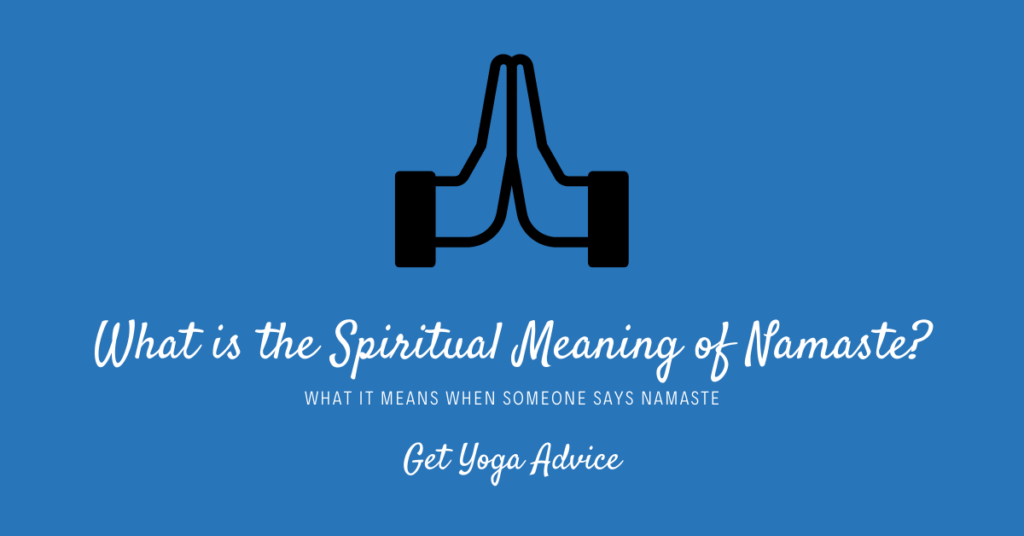If you’ve ever taken a yoga class, you’ve probably heard the term “namaste” (pronounced nah-mah-stay). You’ve likely heard the teacher greet the students with this word, at the beginning and end of a yoga class, but just what is the meaning of namaste?
To embrace and honor the history and origin of this Hindi greeting, it is important to understand where it came from and what it stands for.
Contents
What Does it Mean When Someone Says Namaste?
Namaste is a traditional Hindu greeting that is still used in India and other Hindu parts of Asia. It is usually accompanied by a slight bow and a pose of the hands together at heart level with fingers pointed upwards, elbows out and thumbs pointed toward the speaker.

This positioning of the hands is called the “Namaskar Mudra.” The eyes are closed during the namaste greeting, and there is no physical contact.
In India, Nepal and the Himalayan regions of China, it is common to greet one’s elders, and, in some places, work colleagues, with the namaste greeting.
The contemporary interpretation of the namaste greeting is to acknowledge the spark of the divine in each one of us, very roughly translated as “God be with you.” This divine spark is believed by Hindus to rest in the heart chakra, the part of one’s being where love and compassion reside.
The slight bow, closed eyes and the position of the hands during the namaste greeting indicate respect for what makes each of us special and divine. It is believed by many that the namaste greeting, when performed with solemness and respect, helps promote spiritual growth.
How Do You Respond When Someone Says Namaste?
The traditional response to a greeting of namaste is to repeat the greeting back to the person with a slight bow, closed eyes, hands that are steepled and elbows out. It is essential to give the responsive greeting in a solemn and respectful manner.
These days, the word is also used as a safe greeting to mitigate the spread of COVID-19.
What Language is Namaste From?
“Namaste” is a Hindi word, but it has its roots in the Sanskrit language, a language spoken throughout the Indian subcontinent during the ancient and medieval eras.
Sanskrit is also the language of many of the important texts of Hinduism and Buddhism as well as the root language of Hindi. The word “namaste” is made up of the Sanskrit words for “not I” and “you.”
This translates roughly as a greeting to a peer as giving respect to the person being greeted while not sacrificing one’s one self-esteem. In modern Hindi, “namas” is interpreted to mean “to bow,” making it more of “I bow to you.”
In many contemporary Asian cultures, Namaste is often implied, rather than spoken, with the greeting silent while the person giving the greeting bows slightly with his or her hands steepled and elbows out.
What is the Spiritual Meaning of Namaste?
Despite arguments to the contrary, namaste is more than a simple greeting.
It has a dual meaning. Depending on the context, it can be a respectful and secular greeting or a way of saying hello. However, the Sanskrit phrase can also represent an acknowledgement of another person and their experiences.
Why and How Namaste Is Used in Yoga
Namaste is used in yoga class as a sign of respect and humility. It implies that one is setting one’s ego aside, at least during the class, and meeting the other person (or persons) as an equal(s). It’s best used with the respect for the term’s Sanskrit and spiritual origins and not simply as a catch phrase.
Ideally, the namaste greeting should be used at the beginning and conclusion of each class. It is a way to mark the beginning and the end of a yoga session and thank each other (teacher and students) for the time and energy invested in taking the class.
Says one yoga enthusiast, Miami-based Sara Quiriconi, “The namaste is like a baton pass to take what you’ve learned on the mat with you off the mat to share.”
Final Word on the Meaning of Namaste
The spiritual meaning of namaste has a lot in common with Western cultures. The honor and respect implicit in the greeting are a lot like the familiar adage to “treat your neighbor as you would like to be treated.”
In this hectic, often crass, world in which we live, namaste is a bright oasis of decency. Make sure to give this greeting the solemness and focus it deserves the next time you take a yoga class.



